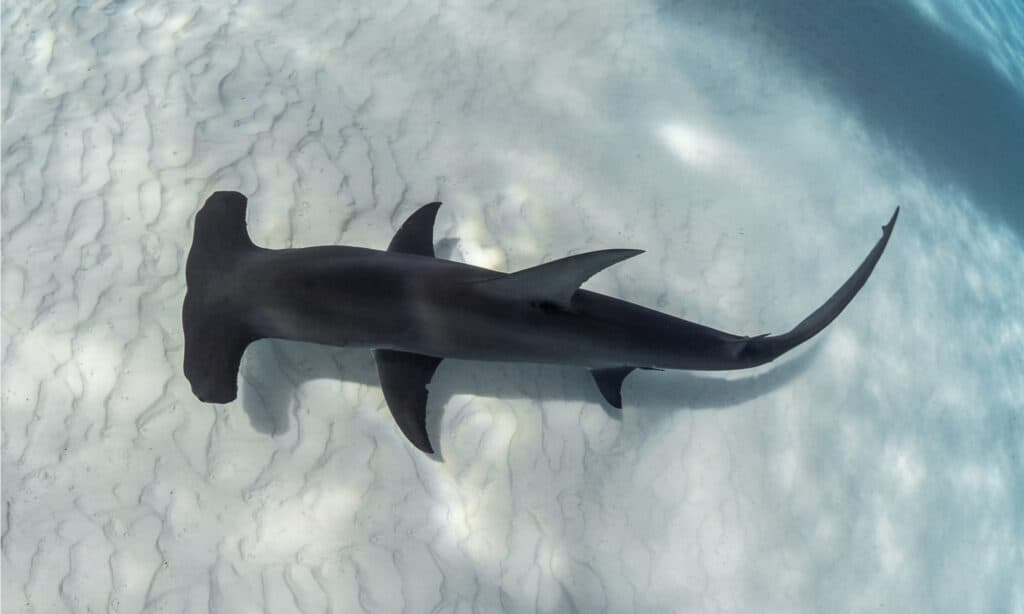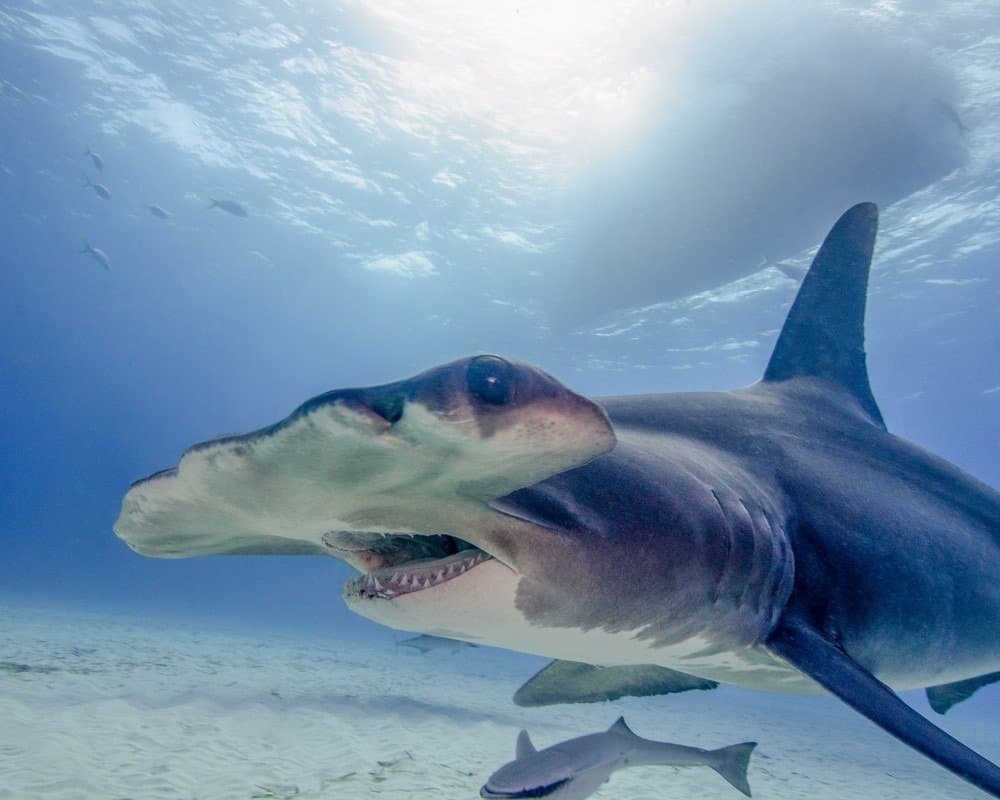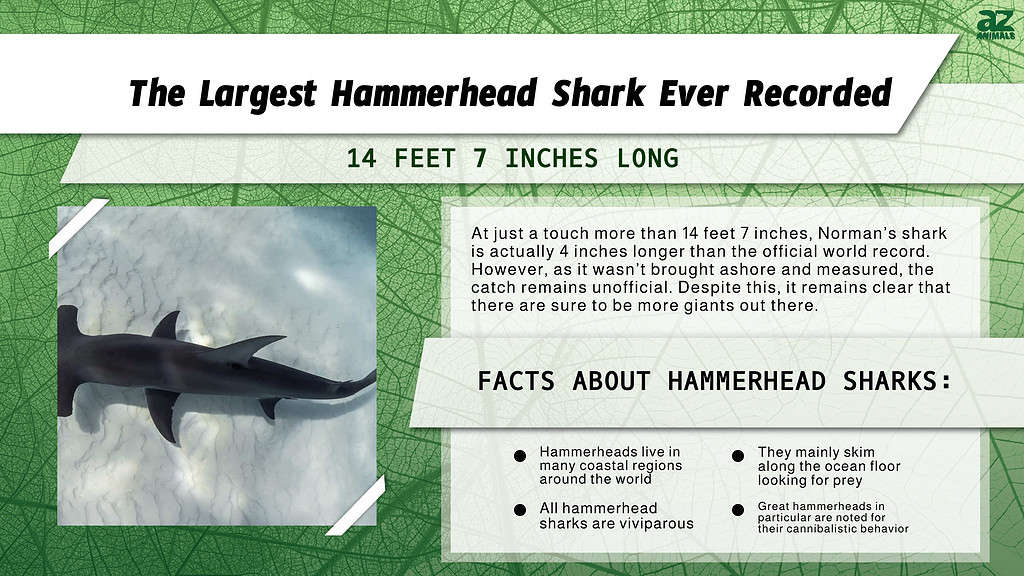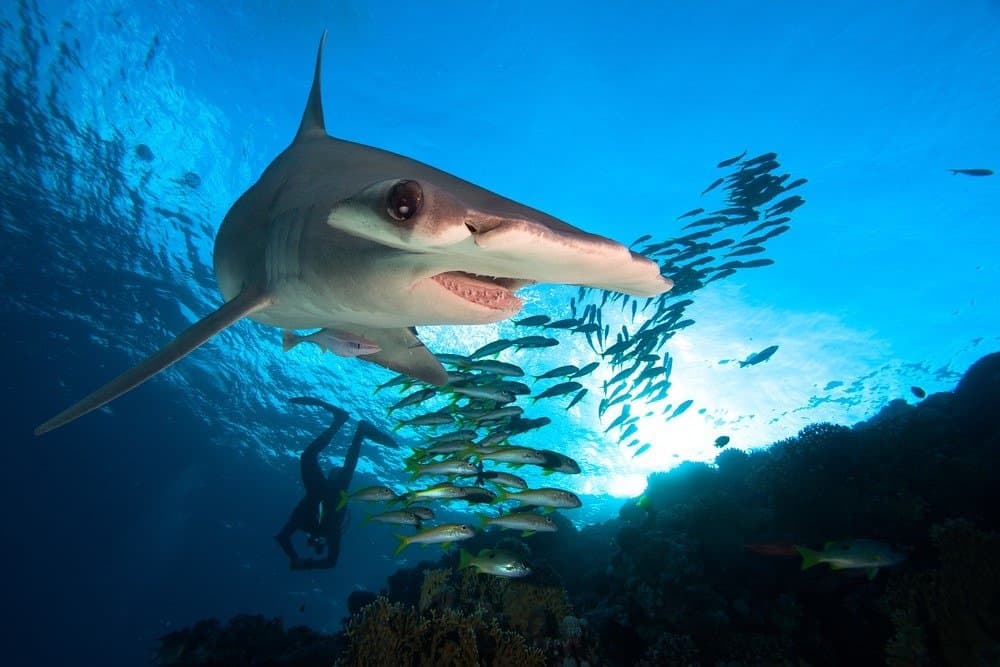There are more than 400 species of sharks alive today in the waters all around the world. However, there are none as unusual as hammerhead sharks. Easily recognizable by their distinctive shaped head, hammerheads live in many coastal regions around the world. Although the smallest of the hammerhead sharks is a little over two feet long, others can grow to incredible sizes. But just how big can they get? Join us as we discover the largest hammerhead shark ever recorded!
About Hammerheads

Hammerhead sharks typically live in warm water along coastlines and continental shelves around the world.
©Sophie Hart/Shutterstock.com
Hammerhead sharks are easily among the most fascinating and unique sharks to roam the seas. They are famous for their distinctive flattened head, which literally looks like the shape of a hammer. Hammerhead sharks are members of the Sphyrnidae family group, of which there are nine species. All but one species are in the genus Sphyrna, while Eusphyra contains only the winghead shark. The largest hammerhead shark species is the great hammerhead, which can reach around 20 feet long.
Hammerhead sharks typically live in warm water along coastlines and continental shelves around the world. They exhibit unusual behavior for sharks in that they tend to spend their days in large schools. However, they split off to hunt on their own during the night. Hammerheads have a varied diet and prey on many different fish, stingrays, octopus, squid, and crustaceans. They mainly skim along the ocean floor looking for prey, and they use their unique heads to great effect when hunting. This is because they frequently use it to pin down stingrays while they bite them. Hammerheads also prey on many other shark species, with gray reef sharks being a particular favorite of great hammerheads.
All hammerhead sharks are viviparous. This means that the embryo develops in an egg inside the female’s body but then hatches so she gives birth to live young. Most hammerheads reproduce once a year and give birth to 12 to 15 pups. However, great hammerheads give birth once every two years to between 20 and 40 pups. Great hammerheads in particular are noted for their cannibalistic behavior, where they eat many of their own young.
The Largest Hammerhead Shark Ever Recorded

Great hammerheads are the largest species of hammerheads, and the largest measured 14 feet and 7 inches long.
©Brent Barnes/Shutterstock.com
The largest hammerhead shark ever recorded was a massive 14 feet 7 inches long. This giant was caught in 2019 by former professional golfer Greg Norman off Palm Beach, Florida. Norman and his friend were in the process of reeling in a blacktip shark when the massive hammerhead approached and began circling the 80-pound shark they had on their line. After an experimental bite, the giant hammerhead snatched the blacktip shark from their line, swallowing it whole.
Never one to back down from a fight, Norman decided to try to catch the hammerhead instead. After a 45-minute battle, he managed to reel the shark into the side of their boat where the reality of just how colossal it was finally began to sink in. Despite the huge shark continuing to fight, they eventually managed to restrain it in the water long enough to measure it before releasing it.
At just a touch more than 14 feet 7 inches, Norman’s shark is actually 4 inches longer than the official world record. However, as it wasn’t brought ashore and measured, the catch remains unofficial. Despite this, it remains clear that there are sure to be more giants out there.
Although not the longest, the heaviest hammerhead ever officially recorded was a 14-foot-long great hammerhead that weighed an impressive 1,280 pounds! This female was caught near Boca Grande in Florida in 2006. The reason for her gigantic weight is that she was actually pregnant with 55 pups at the time.

Stuff of Legends
While Greg Norman’s huge shark remains the largest caught and measured, there are many tales of legendary beasts that make it look like a mere baby in comparison. One such legend tells of a hammerhead so big that it could swallow other sharks with a single bite. This shark was a battle-scarred beast who tormented fishermen in the Florida waters between Everglades City and Tampa Bay … meet “Old Hitler.”
Old Hitler was a huge hammerhead around 20 to 25 feet long with a head rumored to be as wide as a car. His name was coined thanks to a swastika-shaped scar on his forehead, likely from a propeller, and he roamed the seas between the 1960s and 1970s. Old Hitler had a tendency to attack full fishing nets, much to the ire of the fishermen who were trying to eke out a living. One such time, a fisherman attacked him with a knife, but Old Hitler swam away with the knife in his dorsal fin. The next time he turned up, he had a distinctive notch in his fin from where he had shed the knife.
However, Old Hitler wasn’t to be deterred and numerous more times he was attacked — and even caught on fishing lines — yet, he managed to escape. The more the fishermen tried to capture him, the meaner he got, or so the legend says. More and more tales began to be told of him attacking boats and stealing fish.
The story of Old Hitler continues as he has been the subject of many news articles and projects over the years. Old Hitler was never captured, but his legend lives on. Even now, whenever a giant hammerhead turns up in the Florida waters, people still speak of him.
Under Threat?

Hammerheads are regularly caught by fishermen and unfortunately are now in serious decline.
©frantisekhojdysz/Shutterstock.com
While the sight of a massive hammerhead shark is undoubtedly a breathtaking one, the chances of seeing one are fast dwindling, as are their numbers. Eight of the nine species are under threat, with the Carolina hammerhead yet to be assessed. Of those eight, five are critically endangered — scalloped bonnethead, scalloped hammerhead, scoophead, great hammerhead, and small-eye hammerhead — with the remainder either endangered or vulnerable.
The populations of all species of hammerhead sharks are decreasing and the biggest threat to them is us humans. One of the biggest reasons is that hammerheads are regularly caught to be used in shark fin soup. However, although their fins are used, the rest of the meat from them is largely unwanted. Also, even when hammerheads are not the main target, they are regularly caught in nets as bycatch, further adding to their decline.
Sadly, although fishing of hammerheads now comes under strict licensing regulations, there doesn’t seem to be any light at the end of the tunnel for them yet and we risk losing one of the most unique and unusual sharks forever.
The photo featured at the top of this post is © EDGAR PHOTOSAPIENS/Shutterstock.com
Thank you for reading! Have some feedback for us? Contact the AZ Animals editorial team.






